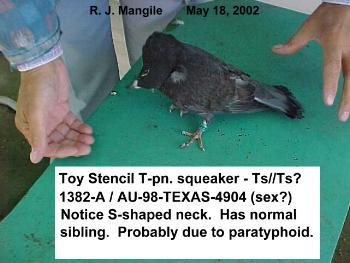
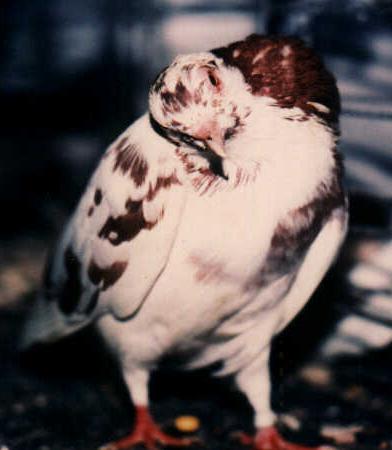
Introducing - The "S-neck"
The two photos above show pigeons with twisted
or S-shaped necks. The red pied S-necked Roller cock (above right)
belonged to Dr. Gerald Dooley. Kerry Hendricks photographed this
bird at the 1987 National Young Bird Show in Louisville, KY. The
6-week old toy stenciled squeaker (above left) from my loft was
photographed by Pegg Smith, on May 18, 2002. Dooley considered
the possibility of a hereditary link to this condition. My current
suspicion is that it is produced by a disease organism - possibly paratyphoid.
Notice opposite twisted neck of each bird.
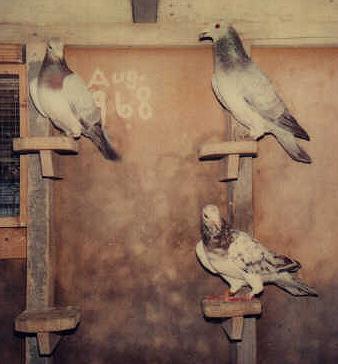 Qualmond (StQ)
Qualmond (StQ)
U. Left:Hemizygous Qualmond
hen
U. Right: Heterozygous
Qualmond cock L. Right - Homozygous
Qualmond cock
~ ~ ~ ~ ~
This photo was take with a Polaroid Camera about 20 years
ago in an effort to resolve the "differences" between Qualmond and Chalky
plumage in my pigeons. My original blue T-pattern Qualmond bird was
a male with much bronzing on the head, neck and wing shields; but the tail
and flights displayed a light almond-like, flecked, bluish-white - void
of bronzing (it may have been heterozygous for recessive red, too.
My experiences are that cocks express more bronzing than hens - with regards
to all the "faded-types" - and it can be reduced or eliminated by selective
breeding. Others were produced with less bronzing; which parallel
my experiences with the Chalky plumage birds. As ironic as it may
seem, I think that "dirty" (V) tends to produce lighter plumage when combined
with faded, qualmond, etc. That implies that by removing the bronzing
and the dirty from a faded, qualmond, etc., plumage it grades towards a
more normal looking blue.
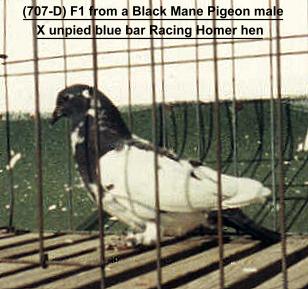 Mane
Pigeon X
Mane
Pigeon X
Racing
Homer Cross.
One of six F1's produced by a black Mane Pigeon (or
Schlmalkalden Moorhead) male paired to an unpied blue bar Racing Homer
female. All had black heads and tails. This squeaker displays
the most white of the six. One sibling was totally black. Notice
the Magpie marking, which may be inducive to "whitesides".
None displayed signs of a head crest. All displayed varying degrees
foot feathering; and one had a "half-muff"? Photo taken in May 1984
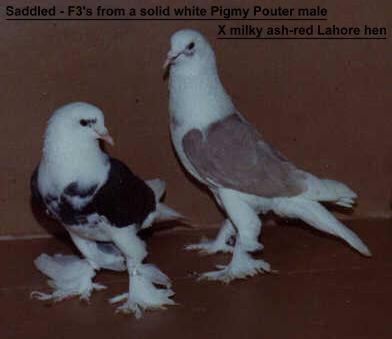 Mangileo's
Mangileo's
The black saddle hen (left)
and milky ash-red cock (right), are F3's from a white Pigmy Pouter
male and a milky ash-red Lahore female. Combining slipper
(sl) from the Pigmy Pouter with grouse (gr)
from the Lahore, eventually produced a "muff".
The saddle markings became a stable pattern by the fifth generation.
Fanciers dubbed them "Mangileo's". Photo
by Kerry Hendricks, May 1975. (See
"Synthetic Muffs In Pigeons", Issue 1, PS&GN - Jan. 1976, p.
16-18.)
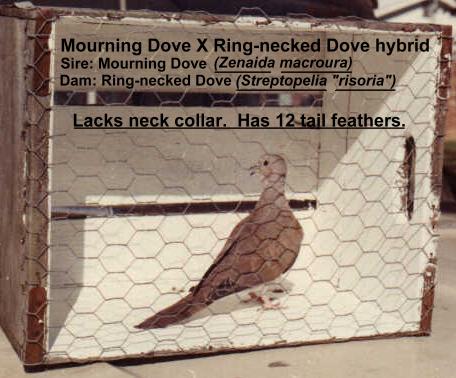 Hybrid
Hybrid
Ring-neck X Mourning Dove
About 25 years ago I received this photo from an apparent
dove fancier in the state of Virgina; with only the following informaiton
written on the back: Hybrid from a Mourning dove cock and a Pied
Ring-neck dove hen. No neck collar & 12 tail feathers.
Fall 1972.
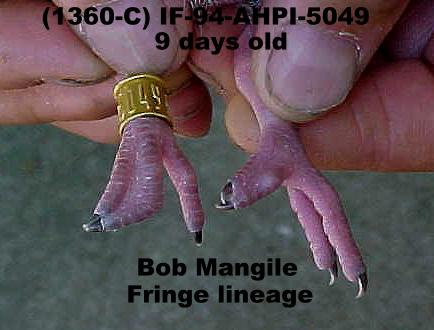 Web
toed squab.
Web
toed squab.
Shown are the feet of a nine day old pigeon (called
a squab) which was produced by two normal toed parent birds. The
right foot (with gold colored band) has the outer and middle toes
webbed to the claws and both claws are fused into one. The left foot
has the inner and the rear toe (hallux) webbed to the claws but
the claws are free and independent of each other. The black
sire is heterozygous for milky and fringe (my+//+fg); and the fringe-milky
dam is homozygous for milky and fringe (myfg//myfg). The recessive
fringe mutation (genetic symbol = fg) produces a somewhat ragged plumage
in pigeons -(when in the homozygous state); but has also been suspected
of playing a role in the production foot and toe malformations. Whether
or not the fringe mutation is involved in the production of such foot/toe
conditions has not yet been resolved. Perhaps there is a linkage
with another mutant that is producing these abnormal foot/toe conditions.
It has already been determined that the fringe mutation is linked with
the mutant called "milky" (gene symbol = my). On June 23, 2001, this
black squab clearly displays a "fringe" (myfg//+fg) plumage. (Photo
by Pegg Smith)
